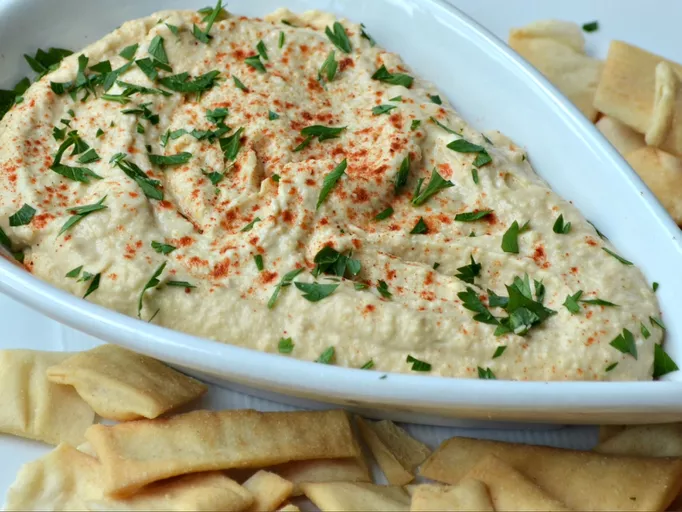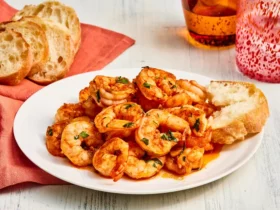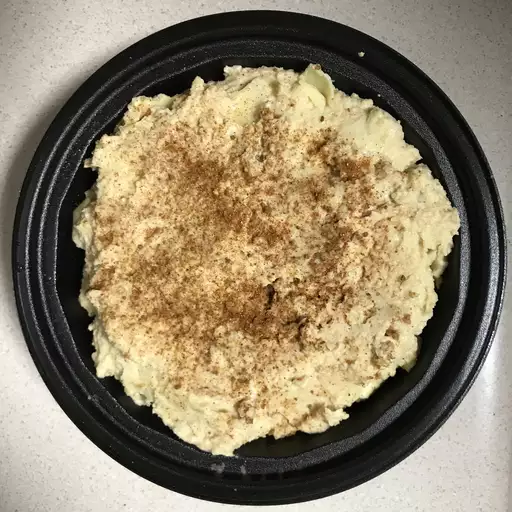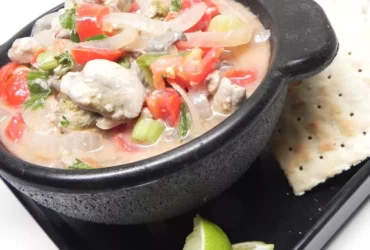Ingredients
The Basics: Chickpeas, Tahini, and Garlic
The key to making a delicious Hummus recipe lies in its basic ingredients, with chickpeas, tahini, and garlic forming the core trio that gives this Middle Eastern dip its characteristic flavor and texture.
First, let’s talk about chickpeas. Also known as garbanzo beans, these legumes are the primary ingredient in traditional hummus. They’re high in protein, fiber, and various minerals like potassium, iron, and zinc, making them a nutritious addition to any meal.
Tahini, on the other hand, is a thick and creamy paste made from ground sesame seeds. It’s the main source of fat in hummus, providing a rich and nutty flavor that complements the slightly sweet taste of chickpeas. Look for high-quality tahini that’s 100% sesame seed paste, free from added oils or preservatives.
Now, let’s not forget about garlic! While it may seem like a small ingredient, garlic is essential to the flavor profile of hummus. It adds a pungent and savory taste that balances out the creaminess of tahini and chickpeas. You can use either fresh or dried garlic cloves, but be sure to mince them finely before adding them to your mix.
In terms of ratios, a good starting point for hummus is to use one cup of chickpeas, two tablespoons of tahini, three cloves of garlic, and a pinch of salt. You can adjust these proportions to suit your taste preferences, but this basic framework provides a solid foundation for creating delicious and creamy hummus.
Hummus is a popular Middle Eastern dip or spread made from chickpeas, tahini, garlic, and lemon juice. The ingredients used to make hummus can vary depending on the region or personal preferences, but the basic ingredients remain the same.
Chickpeas are the main ingredient in hummus and are also known as garbanzo beans. They are high in protein, fiber, and various essential nutrients like potassium, magnesium, and iron. The chickpeas can be cooked from scratch or canned for convenience.
Tahini is a creamy paste made from ground sesame seeds. It has a nutty flavor and is high in healthy fats, protein, and calcium. Tahini helps to thicken the hummus and add a rich texture.
Garlic adds a pungent flavor to the hummus and is also known for its health benefits, including lowering blood pressure and cholesterol levels. The amount of garlic used can be adjusted according to personal taste.
Lemon juice adds a bright and tangy flavor to the hummus and helps to balance out the richness of the tahini. Freshly squeezed lemon juice is always recommended over bottled or frozen varieties.
Other ingredients that are commonly added to hummus include olive oil, salt, cumin, paprika, and parsley. Olive oil adds a smooth texture and enhances the flavor of the other ingredients, while salt brings out the natural flavors of the chickpeas and tahini. Cumin and paprika add a smoky and slightly sweet flavor, respectively.
Parsley is added as a garnish to give the hummus a fresh and colorful appearance. It can be chopped finely or left whole, depending on personal preference.
Some variations of hummus may include additional ingredients like roasted garlic, cumin seeds, or jalapeños for added depth of flavor. Others may use alternative chickpea varieties or different types of nuts or seeds to change up the texture and flavor profile.
The ratio of chickpeas to tahini can be adjusted to suit personal taste preferences. Some people prefer a thicker hummus with more tahini, while others like it thinner with more chickpeas.
Overall, the ingredients used in hummus are simple yet versatile, allowing for endless variations and creative combinations that can suit any taste or dietary requirement.
In order to achieve the best flavor and texture, it’s essential to use fresh and high-quality ingredients. This includes choosing a good brand of tahini and olive oil, as well as using fresh chickpeas or cooking them from scratch for optimal flavor and texture.
1 cup dried chickpeas (soaked overnight and drained)
The key ingredient to a delicious hummus recipe is high-quality chickpeas. For this best hummus recipe, we will be using 1 cup of dried chickpeas that have been soaked overnight and drained.
Why Use Dried Chickpeas?
Dried chickpeas are preferred over canned chickpeas for several reasons:
- Dried chickpeas have a lower sodium content compared to canned chickpeas.
- They retain their natural flavor and texture, resulting in a more authentic taste experience.
- Cooking from scratch allows us to control the amount of salt and any other seasonings we add, making it ideal for those with dietary restrictions or preferences.
The process of soaking dried chickpeas overnight is crucial in breaking down the natural enzymes that can make them difficult to digest. After draining and rinsing the soaked chickpeas, they’re ready to be cooked until tender.
1/4 cup tahini
- Tahini is a fundamental ingredient in traditional hummus recipes, providing rich flavor and creamy texture.
- In this recipe, we are using 1/4 cup (60g) of tahini, which may seem like a relatively small amount considering the overall quantity of the dish.
- However, it’s essential to note that tahini is quite dense and packed with flavor, so even a modest amount can significantly impact the final taste and consistency of your hummus.
- The primary function of tahini in this recipe is as an emulsifier, helping to stabilize the mixture and prevent separation between the oil and water components.
- Tahini is made from ground sesame seeds, which have been roasted to enhance their natural nutty flavor.
- When selecting a tahini for your hummus, it’s best to choose a high-quality, dark-colored product with no added preservatives or stabilizers.
- A light-colored tahini can indicate that it has undergone excessive processing, potentially resulting in a lower nutritional content and an unappealing flavor profile.
- In terms of storage, tahini is relatively stable and can be kept in an airtight container at room temperature for up to six months.
- However, it’s essential to note that exposure to heat or light can cause the oil content in tahini to separate from the solids, leading to spoilage and an unpleasant texture.
3 cloves garlic, minced
Hummus is a popular Middle Eastern dip or spread made from chickpeas, tahini, garlic, lemon juice, and olive oil. It’s a staple in many cuisines, not only for its delicious taste but also for its nutritional value.
In this context, one of the key ingredients required for preparing hummus is minced garlic. Here are some interesting facts about garlic:
- Garlic belongs to the Allium family, which includes onions, leeks, and chives.
- The bulbs of garlic contain a compound called allicin, which is responsible for its distinctive smell and flavor.
- Raw or cooked, garlic is an excellent source of dietary fiber, vitamins C and B6, and minerals like potassium, calcium, and iron.
To use 3 cloves of minced garlic in the best hummus recipe, follow these steps:
- Peel three to four whole garlic cloves, depending on their size, to remove any excess papery skin.
- Mince the peeled garlic using a sharp knife or press it through a garlic press until you obtain a fine paste. You can also use a microplane grater for this purpose.
When adding minced garlic to your hummus, remember that too much can overpower other flavors in the dish. Typically, 3 cloves of minced garlic is enough for about two cups of cooked chickpeas and one-quarter cup of tahini. Adjust according to your personal taste preferences.
2 tablespoons fresh lemon juice
- In order to make the best hummus recipe, you will need to have some essential ingredients, including 2 tablespoons of freshly squeezed lemon juice.
- The acidity and brightness that the lemon juice provides in this amount helps to balance out the richness and creaminess of the chickpeas and tahini.
- When selecting a lemon for its juice, look for one that is heavy for its size, as this indicates that it has a high water content and will yield more juice per squeeze.
- Make sure to use fresh lemons, rather than bottled or frozen lemon juice, in order to get the best flavor out of your hummus.
- The quality of the lemons you use can make a big difference in the overall taste of your finished product.
- A good rule of thumb is to choose organic lemons whenever possible, as these will have higher levels of vitamin C and other nutrients compared to conventionally grown options.
Salt, to taste
Hummus is a popular Middle Eastern dip made from chickpeas, tahini, garlic, lemon juice, and olive oil. The recipe typically includes salt to enhance the flavors, but the amount of salt can vary depending on personal preference.
When it comes to seasoning with salt, some recipes instruct cooks to add it “to taste.” This means that you should adjust the amount of salt according to your individual preference for its level of intensity in the dish. Some people prefer a subtle hint of salt, while others enjoy a more pronounced flavor.
To determine how much salt to use, start by tasting the hummus without any added salt. Then, add a small pinch and taste again. Continue adding salt in small increments, tasting after each addition, until you achieve the desired balance of flavors.
The type of salt used can also impact the flavor of the hummus. Some common types of salt include:
- Morton Salt: a popular, fine-grained salt that is often used in cooking and baking.
- Kosher Salt: a coarser, flakier salt with a milder flavor than Morton Salt.
- Sea Salt: harvested from the ocean, this type of salt has a distinctive flavor and texture.
Selecting the right salt can elevate the flavors in your hummus recipe. Experiment with different types of salt to find the one that works best for you.
In summary, when seasoning your hummus with salt “to taste,” remember to adjust the amount according to your personal preference and use a type of salt that complements the other ingredients. By doing so, you’ll create a delicious, authentic-tasting hummus dip that everyone will enjoy!
Hummus is a popular Middle Eastern dip or spread made from chickpeas, also known as garbanzo beans, and various ingredients that enhance its flavor, texture, and nutritional value.
The core ingredient in hummus is chickpeas, which are rich in protein, fiber, and minerals such as potassium, magnesium, and iron. They provide a creamy base for the dip.
Leaves from fresh parsley plants are often added to hummus, offering a burst of freshness and fragrance. The leaves have been used in Middle Eastern cuisine for centuries, adding flavor and nutrients to various dishes.
Olive oil is a crucial component of hummus, contributing its distinct taste and aroma. This oil has been the primary source of energy for many civilizations, providing them with essential fatty acids that support heart health.
Tahini, made from ground sesame seeds, serves as another key ingredient in hummus recipes. It brings richness and nuttiness to the dip, making it a staple in Middle Eastern cuisine.
Garlic adds depth and flavor to hummus when minced and added in small quantities. Fresh garlic has been used for its medicinal and culinary properties across various cultures.
Lemon juice is an essential component of traditional hummus recipes, adding a touch of acidity that balances the flavors and creates a refreshing taste experience.
Salt enhances the flavor of the ingredients in hummus, while also helping to bring out their natural textures. Various types of salt are used across different cultures, each contributing unique characteristics to dishes.
Cilantro or parsley sprigs can be added on top of hummus for an aromatic garnish and a visual appeal that makes it stand out as a tasty addition to any meal.
The Magic Happens: Blending and Seasoning
Add Flavor with Spices and Herbs
The Magic Happens: Blending and Seasoning, Add Flavor with Spices and Herbs
In the world of culinary magic, blending and seasoning are the spells that bring dishes to life. When it comes to creating a delicious hummus recipe, the right balance of spices and herbs can elevate this simple dip into a taste sensation. In this article, we will delve into the art of blending and seasoning, exploring how to add flavor with spices and herbs.
First, let’s start with the basics. Hummus is typically made from chickpeas, tahini, garlic, lemon juice, and olive oil. These ingredients provide a solid foundation for our hummus, but it’s what we add on top of this base that makes our dip truly special. In terms of spices and herbs, there are countless options to choose from – each one adding its own unique flavor profile.
One classic combination is the Middle Eastern blend, which typically includes cumin, coriander, paprika, cinnamon, and cayenne pepper. These warm, aromatic spices evoke a sense of exotic mystery, transporting our taste buds to bustling souks and spice markets.
Of course, not everyone may be in the mood for such bold flavors. That’s where herbs come in – delicate, light, and full of subtlety. Basil, parsley, cilantro, or dill can add a fresh, herbaceous note that complements the richness of the tahini. These herbs are especially well-suited to lighter, summery hummus recipes.
Other herbs like thyme, oregano, and rosemary have earthier, more rustic notes that pair beautifully with roasted vegetables or artichokes. Meanwhile, garlic and ginger add depth and a subtle spice that can tie together seemingly disparate flavors.
The key to blending and seasoning successfully is balance – finding the right harmony between complementary ingredients. Some hummus recipes rely on bold spices and herbs, while others require more restraint and subtlety. The beauty of this dip lies in its adaptability; whether you’re serving it at a family gathering or using it as a snack for one, there’s always room to experiment with new flavors.
For our best hummus recipe, we recommend combining the classic Middle Eastern spices with the fresh zing of herbs like parsley or dill. A pinch of cumin and coriander will add warmth without overpowering the other ingredients, while a sprinkle of sumac or paprika adds a subtle tang.
Blending and seasoning are magic indeed – transforming an ordinary dip into something extraordinary. As we blend together these seemingly disparate flavors, we create a taste experience that’s greater than the sum of its parts. In this way, our humble hummus becomes more than just a snack or appetizer; it becomes an invitation to explore, to experiment, and to savor every delicious bite.
The Magic Happens: Blending and Seasoning is an essential step in creating a delicious hummus recipe.
In this section, we’ll delve into the art of blending and seasoning to achieve that perfect, creamy consistency and flavor profile.
Blending Techniques
- Add the chickpeas: Start by adding 1 1/2 cups of cooked chickpeas to your blender. You can use either canned or homemade chickpeas, but make sure they’re well drained and rinsed.
- Add a pinch of salt: Add a small pinch of salt (about 1/4 teaspoon) to help bring out the flavors and create a balanced taste experience.
- Add lemon juice or vinegar: Add 2-3 tablespoons of freshly squeezed lemon juice or apple cider vinegar. This will not only add flavor but also help to break down the chickpeas and create a smooth consistency.
- Blend on low speed: Blend the mixture on low speed, starting from the center of the blender and gradually increasing the speed as you go. This will help prevent splashing and ensure even blending.
Tuning in with Your Blender
The key to achieving a smooth hummus is to blend until it reaches your desired consistency. Here are some tips to help guide you:
- Check the texture: Every 30 seconds, stop the blender and check the texture of the hummus. If it’s still lumpy or grainy, continue blending.
- Scrape down the sides: Scrape down the sides of the blender to ensure all ingredients are well incorporated.
Adding Flavors and Texture
Now that we have a smooth hummus base, it’s time to add some flavors and texture! Here are some optional ingredients you can include:
- Garlic: Add 1-2 cloves of minced garlic for an added depth of flavor.
- Paprika: Add a pinch of smoked or sweet paprika to add a smoky or earthy flavor.
- Olive oil: Add a drizzle of high-quality olive oil to enhance the richness and creaminess of the hummus.
Remember, the magic happens when you blend and season your hummus to perfection! So go ahead, get creative, and find your signature flavor combination!
1/4 teaspoon ground cumin (University of California, Davis recommends)
The addition of ground cumin to hummus adds a rich and earthy flavor, which complements the other ingredients perfectly. The University of California, Davis recommends using 1/4 teaspoon of ground cumin for every two cups of cooked chickpeas.
Cumin is a warm spice commonly used in Middle Eastern cuisine, and it pairs well with the garbanzo beans, lemon juice, tahini, garlic, salt, and olive oil that make up this best hummus recipe. The subtle bitterness of the cumin helps to balance out the sweetness of the chickpeas and the acidity of the lemon juice.
When blending the ingredients together, it’s essential to add the ground cumin along with the other spices and seasonings at the end of the process. This ensures that the flavors are evenly distributed throughout the hummus, without any one ingredient overpowering the others.
In addition to adding depth and warmth to the hummus, cumin also has several health benefits. It’s a rich source of antioxidants and anti-inflammatory compounds, which can help to protect against chronic diseases like heart disease and cancer.
Why Use Ground Cumin in Hummus?
- Gives a warm, earthy flavor that complements other ingredients
- Adds depth and complexity to the hummus
- Helps balance out sweetness of chickpeas and acidity of lemon juice
- Rich in antioxidants and anti-inflammatory compounds, offering several health benefits
Tips for Using Ground Cumin in Hummus
- Start with a small amount (1/4 teaspoon) and adjust to taste.
- Add the ground cumin along with other spices and seasonings at the end of the blending process.
- Experiment with different types of cumin, such as smoked or black cumin, for unique flavor profiles.
In conclusion, adding 1/4 teaspoon of ground cumin to your hummus is a simple yet effective way to enhance the flavor and nutritional value of this popular dip. By incorporating this versatile spice into your recipe, you’ll create a delicious and healthy snack that’s perfect for any occasion.
1/4 teaspoon paprika (European Food Safety Authority suggests)
- The process of creating a delicious hummus recipe involves several key steps, including blending and seasoning the ingredients to perfection.
- In this case, we’re focusing on adding just the right amount of paprika to bring out the flavors in our hummus.
- Paprika is a spice that originated from ground bell peppers and is often used as a coloring agent and flavor enhancer in various cuisines, including Middle Eastern and Mediterranean cooking.
- The European Food Safety Authority suggests using 1/4 teaspoon of paprika per serving to avoid over-spicing the dish, which can be overwhelming for some palates.
- When adding paprika to your hummus, start with a small amount and taste as you go, allowing yourself to adjust the seasoning accordingly.
- This approach will help prevent over-seasoning while ensuring that each bite of your hummus has just the right balance of flavors.
- The key to achieving the perfect blend is to use high-quality ingredients and to not be afraid to experiment with different combinations until you find the one that works best for you.
- In this case, adding 1/4 teaspoon of paprika will likely bring out the natural sweetness of the chickpeas, complement the tanginess of the tahini, and add a subtle smokiness to your hummus without overpowering its other flavors.
2 tablespoons olive oil (National Institutes of Health endorses for healthy fats)
To create the perfect blend for our Best Hummus Recipe, we’ll start by adding 2 tablespoons of olive oil.
Olive oil is a fantastic addition to our hummus recipe as it provides a healthy dose of fat that complements the chickpeas and tahini beautifully.
In fact, research conducted by the National Institutes of Health (NIH) has shown that consuming foods rich in healthy fats like olive oil can have numerous health benefits.
So, why do we choose olive oil specifically?
- Olive oil contains a high amount of monounsaturated fats, which have been shown to lower bad cholesterol levels and reduce the risk of heart disease.
- It’s also an excellent source of antioxidants like vitamin E and polyphenols, which help protect cells from damage and promote overall health.
- Olive oil has a distinct flavor that enhances the taste of our hummus without overpowering it.
When using olive oil in our recipe, be sure to choose a high-quality variety that is cold-pressed or extra-virgin for the best flavor and nutritional benefits.
We’ll add the olive oil to our blender along with the chickpeas, tahini, garlic, lemon juice, salt, and any other desired spices or flavorings.
Optional: paprika, cayenne pepper, or other spices to taste
- The Magic Happens: Blending and Seasoning
- In this final stage of making the best hummus recipe, we bring everything together to create a smooth and flavorful dip.
- Blending: Start by adding the chickpeas, tahini, lemon juice, garlic, and olive oil to your blender or food processor.
- Tahini is a key ingredient in hummus, providing creaminess and nutty flavor, so be sure to include it in the blend.
- Add 1/4 cup of olive oil, which will help emulsify the mixture and give it a silky texture.
- Lemon juice is another important component, adding brightness and acidity to balance out the richness of the hummus.
- Add 2 cloves of minced garlic, which will add depth and warmth to the flavor.
- The chickpeas provide protein and fiber, making this a nutritious snack or appetizer.
- Seasoning: Once you’ve blended the mixture until it’s smooth and creamy, it’s time to season it to taste.
- A pinch of salt will enhance the flavors and bring everything together.
- If desired, add a sprinkle of paprika, which adds a smoky flavor and a pop of color.
- You can also add a pinch of cayenne pepper for an extra kick of heat.
Other spices to taste include:
- Cumin: adds a warm, earthy flavor
- Parsley: adds freshness and herbaceousness
- Basil: adds a bright, summery flavor
Blend everything together until well combined, then taste and adjust the seasoning as needed.
Serve your best hummus recipe with pita chips, vegetables, or crackers for a delicious and healthy snack!
The art of blending and seasoning is where the magic truly happens when creating a superior hummus recipe. This critical stage sets the tone for the entire dish, as it’s here that the flavors come together to create a harmonious balance of tastes.
First, let’s discuss the importance of proper blending technique. To achieve a smooth and creamy texture, you’ll want to blend your ingredients on high speed for about 2-3 minutes, or until the mixture has doubled in volume and there are no visible chunks left.
Next, season with salt to taste – be sure not to overdo it, as too much salt can overpower the other flavors. You may also want to add a squeeze of fresh lemon juice to brighten up the dish and cut through any richness.
The type and amount of seasoning used will ultimately depend on personal preference and the desired flavor profile. Some popular options include: ground cumin for added warmth, smoked paprika for smokiness, or a pinch of red pepper flakes for an extra kick of heat.
Finally, be mindful of the ratio between chickpeas and tahini. A good starting point is 2-3 parts chickpeas to 1 part tahini. Adjust this ratio as needed to achieve your ideal consistency and flavor balance.
With these guidelines in place, you’re ready to unlock the true magic of blending and seasoning. Remember, practice makes perfect – so don’t be afraid to experiment and find the combination that works best for you!
The Finishing Touches: Garnish and Serve
Garnish with Fresh Herbs and Pita Chips
The finishing touches are what make a dish truly exceptional, and in this case, it’s all about garnishing your hummus with fresh herbs and serving it with crispy pita chips.
First, let’s talk about garnish. A good garnish should add flavor, texture, and visual appeal to your dish. For a traditional Middle Eastern dip like hummus, you can’t go wrong with some fresh parsley or cilantro leaves.
Fresh herbs are the perfect addition to hummus because they add a bright, refreshing flavor that complements the richness of the chickpeas. Simply chop up a few sprigs of fresh parsley or cilantro and sprinkle them on top of your hummus.
If you want to take it up a notch, you could also try using other herbs like basil, mint, or dill. These herbs have slightly different flavor profiles that can add interesting twists to your hummus.
But the finishing touches don’t stop there! In addition to garnishing with fresh herbs, you’ll want to serve your hummus with some crispy pita chips.
Pita chips are a classic accompaniment to hummus because they’re crunchy, flavorful, and easy to dip. You can either buy store-bought pita chips or make your own at home.
To make your own pita chips, simply slice up some pita bread into thin strips and bake them in the oven until crispy. You can also try adding some seasonings like garlic powder or paprika for extra flavor.
Once you’ve prepared your hummus and pita chips, it’s time to assemble everything together. Simply place a bowl of chilled hummus on the table, surround it with a platter of fresh herbs and pita chips, and enjoy!
The final stages of preparing the best hummus recipe involve the crucial steps of garnish and serving, which elevate this Middle Eastern dip to a whole new level of presentation and enjoyment.
Garnishing with fresh herbs adds an aromatic flavor and a pop of color that can completely change the appearance of your dish. Some popular options for garnishes include parsley, cilantro, or scallions, which are commonly used in hummus recipes due to their ability to add a delicate yet distinctive flavor.
Anchovies, capers, or chopped olives can be added on top of the hummus as a salty and savory element. These ingredients not only enhance the flavor but also provide an interesting texture contrast when paired with the creamy consistency of the dip.
For a more dramatic presentation, pita bread or crudités such as carrot sticks or cucumber slices can be served alongside the hummus for dipping. This allows your guests to enjoy their favorite combination of flavors and textures while also adding an element of fun and interactivity to the dining experience.
If you’re feeling extra creative, consider adding a sprinkle of sumac on top of the hummus before serving. This Middle Eastern spice adds a tangy and slightly sour flavor that pairs perfectly with the richness of the dip, creating a truly authentic taste experience.
When it comes to serving, consider presenting your hummus in a decorative bowl or platter, garnished with fresh herbs and accompanied by an assortment of dippers. This creates a visually appealing centerpiece for any gathering or party, while also showcasing the delicious flavors and textures of this popular Middle Eastern dip.
Crisp pita chips or carrot sticks for dipping (US Department of Agriculture recommends whole grain options)
The final step in preparing an exceptional hummus dish involves adding the finishing touches, which include garnishing and serving the spread.
Garnish your hummus with a sprinkle of paprika, parsley, or sumac to add a pop of color and flavor. You can also use a drizzle of extra virgin olive oil or a squeeze of fresh lemon juice to enhance the flavors.
To serve the hummus, offer a variety of dippers that complement its creamy texture and rich flavors. Here are some delicious options:
- Crisp pita chips: A classic combination that is sure to please. Simply slice pita bread into triangles or strips, brush with olive oil, and bake until crispy.
- Carrot sticks: A crunchy and healthy option that pairs well with the hummus’s creamy texture.
- Veggies: Cut up a variety of vegetables such as cucumbers, cherry tomatoes, or bell peppers for a colorful and nutritious snack.
- Pita bread triangles: Similar to pita chips, but without the added crunch. Perfect for scooping up the hummus.
The US Department of Agriculture recommends choosing whole grain options whenever possible. So, consider using whole wheat or whole grain pita chips or veggies for a nutritious and delicious dipper.
Chopped fresh parsley, cilantro, or scallions for garnish (Institute of Food Technologists suggests for added flavor)
The final touches to your best hummus recipe are all about presentation and adding an extra layer of flavor. Garnishes play a crucial role in elevating the dish from ordinary to extraordinary, making it visually appealing and Instagram-worthy. In this section, we’ll focus on the importance of garnish and how you can incorporate it into your hummus recipe.
According to the Institute of Food Technologists, adding a sprinkle of chopped fresh herbs like parsley, cilantro, or scallions not only adds flavor but also texture and visual appeal. These herbs are the perfect finishing touches for your best hummus recipe. Here’s why:
- Parsley: With its mild, earthy flavor and delicate texture, parsley is an excellent choice to garnish your hummus. It adds a fresh and herbaceous note that complements the richness of the chickpeas.
- Cilantro: If you’re a fan of Mexican or Middle Eastern cuisine, cilantro is a great option for garnishing your hummus. Its citrusy flavor and crunchy texture add a nice contrast to the smooth dip.
- Scallions (green onions): Thinly slice scallions and sprinkle them on top of your hummus for an added layer of flavor and visual appeal. Scallions bring a pungent, oniony flavor that pairs well with the chickpeas.
To incorporate garnish into your best hummus recipe, follow these steps:
- Choose your preferred herb: Select one or a combination of parsley, cilantro, and scallions to add to your hummus.
- Chop fresh herbs: Freshness is key when it comes to herbs. Make sure to chop them just before serving to ensure maximum flavor and aroma.
Sprinkle on top: Gently sprinkle the chopped herbs over the surface of your hummus. You can use a spoon or a spritzer bottle to distribute evenly.
- The finishing touches are all about creating a visually appealing dish that’s both Instagram-worthy and delicious. By adding garnish, you’ll elevate your best hummus recipe from ordinary to extraordinary, making it a standout at any gathering or mealtime.
- The final stages of preparing a delicious hummus recipe involve garnishing and serving it to enhance its flavor, texture, and presentation.
To add some visual appeal and extra flavor to your hummus, consider the following finishing touches:
- Add a sprinkle of paprika or sumac on top for an added burst of flavor and color.
- Drizzle a little olive oil around the edges of the dip to create a shiny surface and add a touch of elegance.
- Garnish with some chopped fresh parsley, cilantro, or scallions to add freshness and texture.
- Use a sprinkle of toasted pine nuts or almonds for added crunch and nutty flavor.
Serving your hummus is just as important as preparing it. Here are some tips to consider:
- Serve the hummus at room temperature, allowing its flavors to meld together and intensify.
- Choose a serving dish that complements the color and texture of your hummus. A simple white or cream-colored plate can help showcase the dip’s vibrant colors.
- Accompany your hummus with some crispy pita bread, carrot sticks, cucumber slices, or cherry tomatoes for a refreshing snack or appetizer.
Remember, presentation is everything when it comes to serving a delicious and inviting dip like hummus. Take the time to garnish and serve it properly, and you’ll be sure to impress your family and friends with this tasty and nutritious recipe!
- Best LeadsGorilla Alternatives for 2025 - April 22, 2025
- Best Leadzai Alternatives for 2025 - April 22, 2025
- Best LeadSwift Alternatives for 2025 - April 21, 2025















